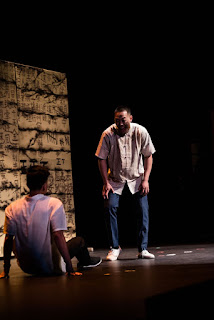Week 8: Nanotechnology and Art
Although nanotechnology has been advancing rapidly, the field itself is one that most people do not understand. Ironically though, most people have had exposure to nanotechnology. As mentioned in lecture, it is prevalent in products that are used by most consumers, like cosmetics, diet supplements, agrochemicals, and sunscreen. Additionally, Jim Gimwezki talks about how nanotechnology has been utilized to tackle some of our world's most serious issues, like how silver nanoparticles are being utilized in food packaging because its antimicrobial nature is better for the environment. In Ray Kurzweil's TED Talk, he discusses how society is inching closer and closer to unlocking nanotechnology's potential - that in the imminent future, nanotechnology will enable us to fit all of a phone's features and functionality into a device the size of a single blood cell.
As far as the integration of nanotechnology and art goes, the combination of the two gives viewers the opportunity to challenge, investigate, and critique the material world and find new ways in which to see and experience art from a minuscule, technological perspective. For example, Boo Chapple (Art Base) has worked on the Transjuicer, an art piece that uses nanotechnology's capabilities to create audio speakers out of bone - utilizing the piezoelectric quality of bone matrices to induce vibrations and create sound. His research and integration of nanotechnology explore a sonic realm that was once beyond human capacity and explore it in a way that pushes the boundaries as to what art is and how it can be created.
Additionally, Christa Sommerer and Laurent Mignonneau created Nano-Scape, which attempted to make the nano-world possible to access through touch. Essentially, it is a magnetic force-feedback network that enables people to physically interact with nano particles to create an invisible, malleable, and constantly changing sculpture. Users will attempt to comprehend the invisible sculptures design and structure through touch, resulting in a sensory, personal exploration and interpretation process that is unique in regards to a user's experience and interaction with art.
"Art in the Age of Nanotechnology." Art.Base. N.p., 11 Mar. 2010. Web. 29 May 2017.
Kurzweil, Ray. TED. TED Conferences, LLC, Feb. 2009. Web. 29 May 2017.
When Nanotechnology Meets Art”. Science and Religion.com. n.p., 20 Apr 2011. Web. 29 May 2017.
Uconlineprogram. "Nanotech Jim Pt3." YouTube. YouTube, 21 May 2012. Web. 29 May 2017.
Uconlineprogram. "Nanotech Jim Pt6." YouTube. YouTube, 21 May 2012. Web. 29 May 2017.
As far as the integration of nanotechnology and art goes, the combination of the two gives viewers the opportunity to challenge, investigate, and critique the material world and find new ways in which to see and experience art from a minuscule, technological perspective. For example, Boo Chapple (Art Base) has worked on the Transjuicer, an art piece that uses nanotechnology's capabilities to create audio speakers out of bone - utilizing the piezoelectric quality of bone matrices to induce vibrations and create sound. His research and integration of nanotechnology explore a sonic realm that was once beyond human capacity and explore it in a way that pushes the boundaries as to what art is and how it can be created.
Additionally, Christa Sommerer and Laurent Mignonneau created Nano-Scape, which attempted to make the nano-world possible to access through touch. Essentially, it is a magnetic force-feedback network that enables people to physically interact with nano particles to create an invisible, malleable, and constantly changing sculpture. Users will attempt to comprehend the invisible sculptures design and structure through touch, resulting in a sensory, personal exploration and interpretation process that is unique in regards to a user's experience and interaction with art.
Works Cited:
"Art in the Age of Nanotechnology." Art.Base. N.p., 11 Mar. 2010. Web. 29 May 2017.
Kurzweil, Ray. TED. TED Conferences, LLC, Feb. 2009. Web. 29 May 2017.
When Nanotechnology Meets Art”. Science and Religion.com. n.p., 20 Apr 2011. Web. 29 May 2017.
Uconlineprogram. "Nanotech Jim Pt3." YouTube. YouTube, 21 May 2012. Web. 29 May 2017.
Uconlineprogram. "Nanotech Jim Pt6." YouTube. YouTube, 21 May 2012. Web. 29 May 2017.






I really liked how you expanded from ideas brought up in lecture to include the Transjuicer and Nano-Scape artworks. The concept of the Transjuicer is certainly interesting and obviously requires extensive research in acoustics and the organic bone material on a nano-level. I wonder if these speakers will have real-world applications at some point in the near future.
ReplyDelete